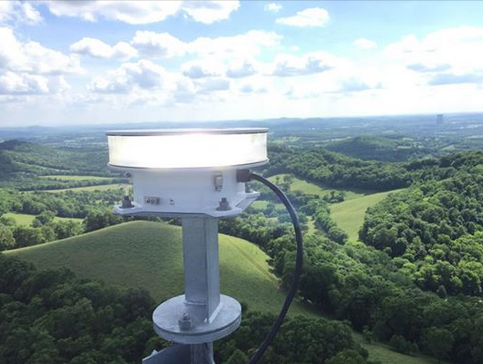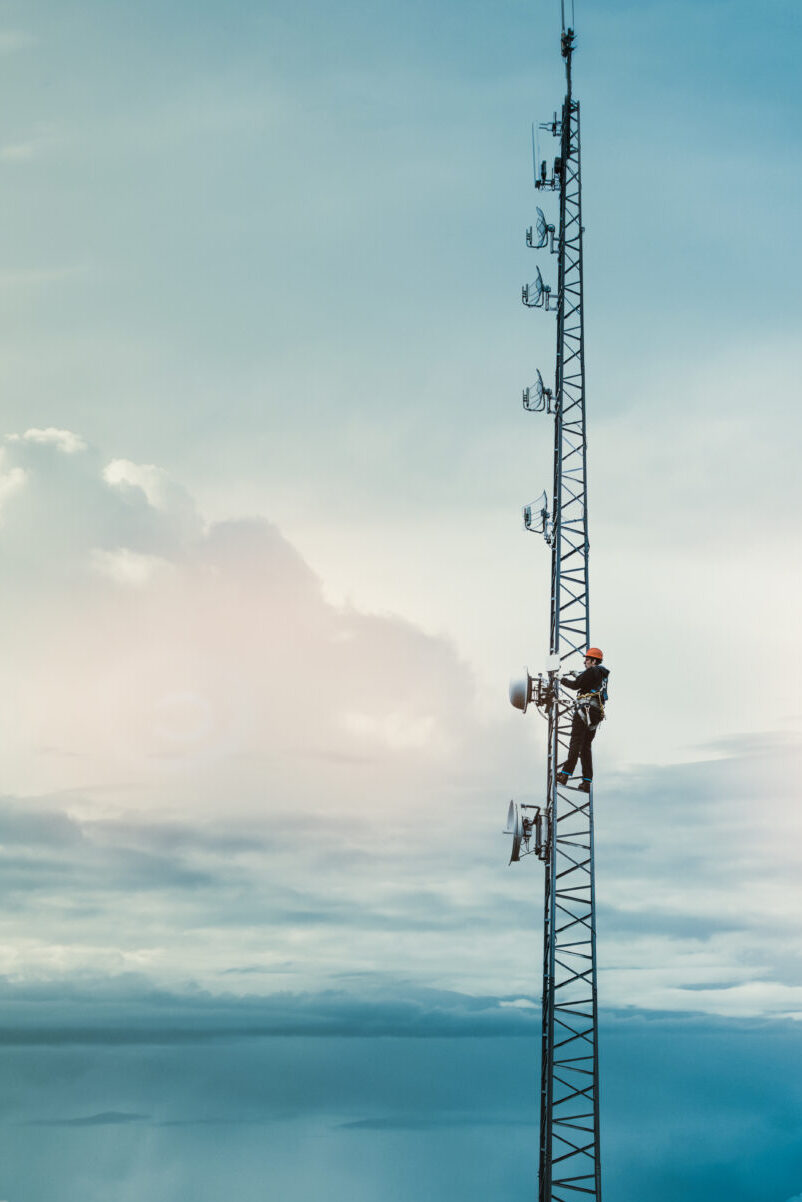How LED is Transforming Obstruction Lighting
The Civil Aeronautics Administration (CAA) and its successor, the Federal Aviation Administration (FAA) have an intense focus on air navigation safety. Obstructions are defined as any structure that penetrates air navigation space. Since the early 20th century, the FAA has studied the risks associated with flying at low altitudes. As a result of their findings, they published rules and regulations to define how to mark obstructions to keep pilots safe.
Until the 1960s, the FAA required that structures exceeding 200 feet be painted with alternating orange and white bands to enhance daytime visibility for pilots and avoid collision. They also mandated that these structures be lit with red lighting at night to warn pilots of the presence of tall structures in their flight paths.
Over the years, the FAA has maintained its focus on safety by conducting various studies to determine the most effective markings of obstructions. The results were shared with the industry and have been instrumental in saving countless lives through effective obstruction marking.
Invented by Thomas Edison in 1879, incandescent lighting works by passing an electrical current through a thin filament, heating it until it glows and emits light. Throughout the 20th century, incandescent lamps were the primary source of illumination in the obstruction industry for nighttime marking.
While incandescent bulbs were relatively inexpensive and easy to manufacture, they had significant limitations. Typically, incandescent bulbs have a short operational lifespan of about one (1) year or approximately 4,000 hours in obstruction fixtures, necessitating annual lamp maintenance.
Incandescent beacons are extremely inefficient, consuming approximately 1,240W of power, most of which is converted into heat rather than light. Due in part to this inefficiency, Congress initiated phasing out incandescent lighting in 2007 under the Energy Independence and Security Act. To promote energy-efficient alternatives, it became illegal in the United States as of 2022 to manufacture or sell incandescent bulbs that produced less than 45 lumens per watt.
In the absence of a more efficient alternative, incandescent lights became the standard in obstruction lighting. However, growing demand for a more durable and higher performing solution drove the development of new technologies.
The emergence of xenon lighting offered the industry an improvement over incandescent technology. This technology generates light by passing an electric current through a tube filled with xenon gas, creating an arc that produces a bright white or bluish light. Xenon lamps offer greater brightness and substantially higher durability compared to incandescent bulbs. Additionally, unlike some incandescent lights that require a warm-up time, xenon lights deliver instant illumination at full intensity.
Xenon beacons consume 130W of energy for white light during the day and 145W for red light at night. Due to their improved efficiency, xenon lights have longer lifespans than incandescent bulbs, lasting between two to three years (approximately 8,000 to 12,000 hours) in obstruction fixtures.
Maintaining FAA paint specification can be difficult and expensive, but xenon products offer substantial power savings and provide a white daytime marking option that structure owners welcome as a viable alternative.
While xenon technology represented an improvement over incandescent lighting, it still had its limitations.
Rising global demand for a more sustainable, energy-efficient, and durable lighting solution led to the development of the lighting-emitting diode (LED) technology. LEDs have since been widely adopted across various markets, including automotive, commercial, industrial, and aviation obstruction lighting. The advent of LED lighting has provided the obstruction tower industry with a reliable, long-lasting, and cost-effective lighting solution.
Invented in 1962, LEDs operate by running an electric current through a semiconductor diode, which emits energy as light photons. The process is highly efficient, generating bright and uniform illumination. Advances in LED technology have enabled precise tuning of the light’s wavelength and strict manufacturing tolerances.
Converting to LED technology is more than just an upgrade for obstruction tower owners. It is a strategic move that ensures FAA compliance, reduces operating costs, and supports sustainability efforts.
The FAA has recognized the operational and safety benefits achieved through LED lighting and has been a key proponent of the technology. Their continuous real-world lighting testing and pilot feedback on obstruction identification plays a crucial role in shaping effective obstruction lighting specifications.
The FAA’s obstruction lighting regulations are detailed in Advisory Circular AC 70/7460-1, and LED technology meets those requirements with superior visibility, energy efficiency, and reduced maintenance needs. SPX Aids to Navigation meets the FAA’s requirements to enhance safety, improve lighting reliability, and promote energy conservation goals, making LED the strategic choice for obstruction tower operators seeking to comply with regulations while reducing operational costs.

Like xenon lights, LEDs turn on instantly without warm-up time, delivering immediate visibility along with superior brightness and consistent light output. They offer greater control and customization options, such as dimming and color tuning, which are useful for specific tower lighting needs. Unlike xenon and incandescent lamps, LEDs provide directional illumination, focusing light precisely where it is needed to enhance both efficiency and visibility.
LED lighting offers enhanced durability in harsh environments since each diode is encapsulated to protect the electronic elements. Along with its filament-free design, LEDs are highly resistant to vibration, shock, and extreme temperatures, making them well-suited for tower lighting exposed to harsh environments.
When xenon or incandescent lights suffer a single point of failure, the entire fixture becomes inoperable. In contrast, LED technology uses clusters of individual LEDs, allowing the fixture to maintain adequate brightness even if up to 25% of the LEDs fail, ensuring the lighting fixture always meets brightness specification.
LEDs can be integrated with smart systems that enable remote control and monitoring, improving operational oversight, and supporting predictive maintenance.
and Ease of Maintenance
Due to their inherent technology and directional light emission, LED systems consume significantly less power than xenon light sources, leading to substantial energy savings. This reduction not only lowers operational costs but also reduces the carbon footprint. For example, a typical LED system for an E1 tower, the most common type of tower in operation, uses only 42% of the energy consumed by a comparable xenon system.
Per FAA AC 150/5345-43J, alternative light sources to xenon and incandescent are proven to meet the requirements. LEDs not only meet but exceed this requirement. With an operational lifespan lasting more than 100,000 hours, they far surpass xenon’s 8,000-12,000 hours. This extended service life eliminates the need for frequent flash tube replacements and significantly reduces maintenance demands, a major advantage for towers located in remote areas or difficult-to-access towers.

Xenon bulbs from various suppliers have been found to contain mercury, posing hazards to the environment. The presence of hazardous chemical components makes the proper disposal of xenon lighting a significant environmental challenge.
In contrast, LEDs do not contain hazardous materials such as mercury or xenon, making them more environmentally friendly and easier to recycle. Their significantly lower energy consumption reduces greenhouse gas emissions, supporting broader carbon reduction goals. Additionally, the straightforward recycling process
minimizes disposal concerns for tower owners.
in the Supply Chain
Incandescent lights are based on outdated technologies. The shrinking demand for these types of systems has resulted in an exodus of suppliers and a shortage of spare parts. Since the enactment of the Energy Independence and Security Act in 2007, incandescent lights for obstruction lighting must now be sourced from overseas suppliers, often at higher costs and subject to import tariffs.
As demand for xenon lighting declines, obtaining xenon light sources and compatible components has become increasingly difficult, with many suppliers discontinuing related products.
Recent supply chain disruptions, such as those caused by COVID-19, have worsened logistical challenges and forced some vendors out of the market. In contrast, LED systems have remained resilient, supported by strong demand and a broader, more diverse supplier base.
LED lighting systems have been in widespread use for over fifteen years, consistently demonstrating their reliability and energy efficiency in the field. Although operational costs per tower can be reduced, the real savings in the total cost of
ownership of these systems come from reduced labor expenses due to extended mean time between failures.
An LED lamp typically lasts between five to ten years before requiring a truck roll, compared to a xenon system that needs servicing every two years. This translates to an estimated annual savings of $1500 per lit site.
Publicly traded companies often implement Environmental, Social, and Governance (ESG) initiatives, with a strong focus on sustainability and reducing carbon emissions. Upgrading to energy-efficient LED systems not only lowers operational costs but also provides a compelling way to showcase environmental initiatives to investors. Moreover, including a clear LED conversion plan within the ESG strategy can strengthen loan applications and potentially lead to lower interest rates on tower project financing.

with SPX Aids to Navigation
The transition from xenon to LED lighting in the obstruction tower industry is a strategic decision driven by the need for increased efficiency, lower operational costs, and improved sustainability. Supported by the FAA and backed by the clear performances and energy-saving benefits of LEDs, tower operators should weigh the long-term advantages of this transition. Implementing an LED upgrade plan helps eliminate the risk of an unexpected and catastrophic lighting failure and avoids the emergency replacement of lighting systems.
SPX Aids to Navigation manufactures reliable, compliant obstruction lighting and monitoring solutions that ensure aircraft safety. As part of a comprehensive, long-term strategy to transition to LED solutions, SPX Aids to Navigation can provide maintenance services, spare parts such as the FlashBack and FlashBack+ Spares Pack, field support, and monitoring through its Tennessee-based National Operations Center (NOC).

